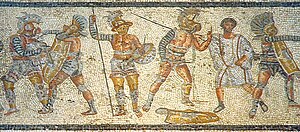334
Appearance
| Millennium: | 1st millennium |
|---|---|
| Centuries: | |
| Decades: | |
| Years: |
| 334 by topic |
|---|
| Leaders |
| Categories |
| Gregorian calendar | 334 CCCXXXIV |
| Ab urbe condita | 1087 |
| Assyrian calendar | 5084 |
| Balinese saka calendar | 255–256 |
| Bengali calendar | −259 |
| Berber calendar | 1284 |
| Buddhist calendar | 878 |
| Burmese calendar | −304 |
| Byzantine calendar | 5842–5843 |
| Chinese calendar | 癸巳年 (Water Snake) 3031 or 2824 — to — 甲午年 (Wood Horse) 3032 or 2825 |
| Coptic calendar | 50–51 |
| Discordian calendar | 1500 |
| Ethiopian calendar | 326–327 |
| Hebrew calendar | 4094–4095 |
| Hindu calendars | |
| - Vikram Samvat | 390–391 |
| - Shaka Samvat | 255–256 |
| - Kali Yuga | 3434–3435 |
| Holocene calendar | 10334 |
| Iranian calendar | 288 BP – 287 BP |
| Islamic calendar | 297 BH – 296 BH |
| Javanese calendar | 215–216 |
| Julian calendar | 334 CCCXXXIV |
| Korean calendar | 2667 |
| Minguo calendar | 1578 before ROC 民前1578年 |
| Nanakshahi calendar | −1134 |
| Seleucid era | 645/646 AG |
| Thai solar calendar | 876–877 |
| Tibetan calendar | 阴水蛇年 (female Water-Snake) 460 or 79 or −693 — to — 阳木马年 (male Wood-Horse) 461 or 80 or −692 |

Year 334 (CCCXXXIV) was a common year starting on Tuesday (link will display the full calendar) of the Julian calendar. At the time, it was known as the Year of the Consulship of Optatus and Caesonius (or, less frequently, year 1087 Ab urbe condita). The denomination 334 for this year has been used since the early medieval period, when the Anno Domini calendar era became the prevalent method in Europe for naming years.
Events
[edit]By place
[edit]Roman Empire
[edit]- Flavius Dalmatius puts down a revolt in Cyprus, led by Calocaerus. Calocaerus is brought to Tarsus (Cilicia), and executed.[1]
- The Goths protect the Danube frontier against an invasion by the Vandals.[2][3]
- Emperor Constantine the Great reauthorises gladiatorial combat.
Births
[edit]- Huiyuan, Chinese Buddhist teacher and founder of Donglin Temple (d. 416)[4]
- Sabbas the Goth, Christian reader and saint (d. 372)[5]
- Virius Nicomachus Flavianus, Roman historian and politician (d. 394)[6]
Deaths
[edit]- December 5 – Li Ban, Chinese emperor of Cheng-Han (b. 288)
- Calocaerus, Roman usurper[1]
- Li Xiong, Chinese emperor of Cheng-Han (b. 274)[7]
- Shi Hong, Chinese emperor of the Jie state (b. 313)[8]
- Tao Kan (or Shixing), Chinese general and politician (b. 259)[9]
- Wei Huacun (or Xianan), Chinese religious leader (b. 252)[10]
- Yang Nandi, Chinese general and ruler of Chouchi
References
[edit]- ^ a b Pohlsander, Hans A. (2004). The Emperor Constantine (2nd ed.). Routledge. p. 78. ISBN 978-0-415-31938-6.
- ^ Kraitser, Charles V. (1837). The Poles in the United States of America. Kiderlen and Stollmeyer. p. 17.
- ^ Townsend, George Henry (1862). The Manual of Dates (2nd ed.). Routledge, Warne & Routledge. p. 757.
- ^ Zürcher, Erik (1959). The Buddhist conquest of China. Vol. 1. Brill Archive. p. 16.
- ^ Hodgkin, Thomas (1892). Italy and Her Invaders. Vol. 1 (2nd ed.). Clarendon Press. p. 178.
- ^ Adkins, Lesley; Adkins, Roy A. (2004). Handbook to life in ancient Rome (2nd ed.). Infobase Publishing. p. 17. ISBN 978-0-8160-5026-0.
- ^ Mutschler, Fritz-Heiner; Mittag, Achim (2008). Conceiving the empire: China and Rome compared. Oxford University Press. p. 397. ISBN 978-0-19-921464-8.
- ^ Frédéric, Louis (1977). Encyclopaedia of Asian civilizations. Vol. 3. p. 178.
- ^ Pearce, Scott (2001). Spiro, Audrey G.; Ebrey, Patricia Buckley (eds.). Culture and Power in the Reconstitution of the Chinese Realm, 200–600. Harvard Univ Asia Center. p. 76. ISBN 978-0-674-00523-5.
- ^ Liu, Cheng-Tsai; Zheng-Cai, Liu; Hua, Ka (1999). A Study of Daoist Acupuncture. Blue Poppy Enterprises, Inc. p. 17. ISBN 978-1-891845-08-6.
